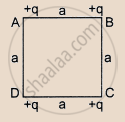Advertisements
Advertisements
प्रश्न
A particle of mass m and charge (−q) enters the region between the two charged plates initially moving along x-axis with speed vx (like particle 1 in the fig.). The length of plate is L and an uniform electric field E is maintained between the plates. Show that the vertical deflection of the particle at the far edge of the plate is qEL2/(2m`"v"_"x"^2`).

उत्तर
Charge on a particle of mass m = − q
Velocity of the particle = vx
Length of the plates = L
Magnitude of the uniform electric field between the plates = E
Mechanical force, F = Mass (m) × Acceleration (a)
`"a" = "F"/"m"`
However, electric force, F = qE
Therefore, acceleration, `"a" = ("qE")/"m"` ......(1)
Time taken by the particle to cross the field of length L is given by,
t = `"lenght of the plate"/"Velocity of the particle" = "L"/"v"_"x"` .......(2)
In the vertical direction, initial velocity, u = 0
According to the third equation of motion, vertical deflection s of the particle can be obtained as,
`"s" = "ut" + 1/2"at"^2`
`"s" = 0 + 1/2("qE"/"m")("L"/"v"_"x")^2`
`"s" = ("qEL"^2)/(2"m""v"_"x"^2)` ........(3)
Hence, the vertical deflection of the particle at the far edge of the plate is qEL2/(2m`"v"_"x"^2`).
This is similar to the motion of horizontal projectiles under gravity.
APPEARS IN
संबंधित प्रश्न
Find the dimensional formula of ε0.
Suppose the second charge in the previous problem is −1.0 × 10−6 C. Locate the position where a third charge will not experience a net force.
Estimate the number of electrons in 100 g of water. How much is the total negative charge on these electrons?
Consider a gold nucleus to be a sphere of radius 6.9 fermi in which protons and neutrons are distributed. Find the force of repulsion between two protons situated at largest separation. Why do these protons not fly apart under this repulsion?
Four equal charges of 2.0 × 10−6 C each are fixed at the four corners of a square of side 5 cm. Find the Coulomb's force experienced by one of the charges due to the other three.
Find the speed of the electron in the ground state of a hydrogen atom. The description of ground state is given in the previous problem.
Two particles A and B possessing charges of +2.00 × 10−6 C and of −4.00 × 10−6 C, respectively, are held fixed at a separation of 20.0 cm. Locate the points (s) on the line AB, where (a) the electric field is zero (b) the electric potential is zero.
Two equal charges, 2.0 × 10−7 C each, are held fixed at a separation of 20 cm. A third charge of equal magnitude is placed midway between the two charges. It is now moved to a point 20 cm from both the charges. How much work is done by the electric field during the process?
A total charge Q is broken in two parts Q1 and Q2 and they are placed at a distance R from each other. The maximum force of repulsion between them will occur, when ____________.
Two identical thin rings, each of radius a meter, are coaxially placed at a distance R meter apart. If Q1 coulomb and Q2 coulomb are respectively the charges uniformly spread on the two rings, the work done in moving a charge q coulomb from the centre of one ring to that of the other is ______.
Four equal charges q are placed at the four comers A, B, C, D of a square of length a. The magnitude of the force on the charge at B will be ______.

Two charge – 10c and + 10 c are placed 10 cm apart. Potential at centre of the line joining the two charge is:-
The capacity of an isolate conducting sphere of radius R is proportional to
The S.I unit of electric permittivity is
Electric charge of any system is ______.
Two charges q and – 3q are placed fixed on x-axis separated by distance ‘d’. Where should a third charge 2q be placed such that it will not experience any force?
Two point charges +2 C and +6 C repel each other with a force of 12 N. If a charge of -4 C is given to each of these charges, then the force now is ______.
What is meant by the statement: "Relative permittivity of water is 81"?
